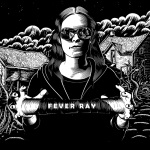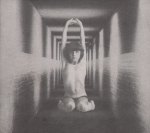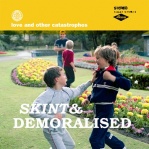Handy idea from AT&T. Check out the rest here – AT&T Hands
Posted in Sound of the Brand
AT&T
Handy idea from AT&T. Check the rest out here – AT&T Hands
Posted in Sound of the Brand
Where’s That Sound Coming From?

And your word for the day is…’diegetic’. Diegetic and non-diegetic are cinematic terms relating to the use of sound in a film. Diegetic refers to sound whose source is visible on the screen, or whose source is implied to be present by the action of the film. Where as non-diegetic is sound whose source is neither visible on the screen nor has been implied to be present in the action. A film’s music soundtrack is nearly always non-diegetic, creating a sense of mood and accentuating key moments in a film’s plot. In this clip from Mel Brooks‘ film High Anexity, he cleverly plays with this convention – moving the music from non-diegetic to diegetic – enjoy. – Brian Kelly, Creative Director, soundlounge.
Posted in advertisements, Audio Perception, Music Consultants, Music Misc, Sound Design | Tags: Advertising, film music, film sound, Sound, soundtrack
We’ve Moved!
Dear loyal soundlounge readers,
We’ve moved our blog to the site soundlounge.co.uk/blog. See you there!
If you’ve enjoyed reading our articles thus far, we’ll happily invite you to subscribe to the new blog site.
Posted in Soundlounge News
Overtones: The Secret Spices of Musical Sauce
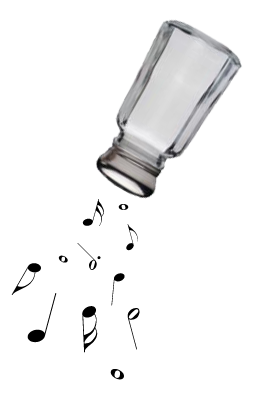 In sonic branding, much thought and effort goes into finding the perfect sounds to fit a brand’s style. Part of this process involves breaking these sounds into their essential ingredients and critiquing them: “That trumpet is a shade too mellow. Can we find one with more punch?” or “We need to decide if we want a brighter voice or a darker voice.”
In sonic branding, much thought and effort goes into finding the perfect sounds to fit a brand’s style. Part of this process involves breaking these sounds into their essential ingredients and critiquing them: “That trumpet is a shade too mellow. Can we find one with more punch?” or “We need to decide if we want a brighter voice or a darker voice.”
Every musical detail counts in the advertising world. Think of the Intel Inside sound, one of the most memorable audio logos of all time – only three seconds long. Creator Walter Werzowa needed a keen ear to carefully design each sound. In the first note alone, he used over 20 different instruments and sounds!

Did you hear the anvil, tambourine, and electric spark? If you’re like most listeners, probably not (we’ll get to the reason for this later). But Werzowa hand-picked each of these sounds for a reason. He knew their unique sound “flavours” and was able to mix them perfectly into a memorable audio logo.
We can all tell when an instrument sounds right or wrong in a certain context. This is the “I’ll know it when I hear it” approach, which drives many sound branding decisions. But when it comes down to a few seconds of sound design, it’s important to understand why an instrument sounds mellow, punchy, bright, or dark.
With a little science and an open ear, we’ll explore some of the basic “spices” of sound undiscovered by the average listener – overtones.
Can you sing more than one note at the same time?
Tuvan musician Kongar-ol Ondar employs an age-old Tuvan tradition of overtone singing to sing two, three, or four notes at the same time in this clip from the Late Show with David Letterman:
“How did he do that?!” you might be thinking. Let’s take a closer look at overtones – read on…
Charlie McCarron
Sound Consultant
soundlounge
Posted in Audio Perception, Creative Consulting, Sound of the Brand | Tags: instruments, Intel, Kongar-ol Ondar, overtones, pasta sauce, singing, Sound of the Brand
Birds and Brands
 From Frank Lloyd Wright’s organic architecture to the sticky burrs that inspired Velcro, nature has often played a role in creative design, so what can the natural world teach us about brand recognition through the creative use of sound? Let’s take a look at one of nature’s best musicians who has a knack for sonic branding – the bird…
From Frank Lloyd Wright’s organic architecture to the sticky burrs that inspired Velcro, nature has often played a role in creative design, so what can the natural world teach us about brand recognition through the creative use of sound? Let’s take a look at one of nature’s best musicians who has a knack for sonic branding – the bird…
A male bird’s song may sound like a simple melody to the casual human listener. But to a female bird, this song acts as a revealing personal profile. Just a few notes will disclose a wealth of information concerning his mental health, testosterone levels, diseases carried, etc. Unlike a guitar-strumming human singer who easily melts the hearts of his groupies, a male bird undergoes intense scrutiny when singing to a potential mate. If a bird’s song misses the mark, it’s a reflection on his character, and the female will fly off to try her luck with another singer. On the other hand, if his performance meets her expectations for a suitable partner, he has won her heart and her trust.
Like a bird’s personally revealing song, quite a bit is divulged about a company through the music and sounds they chose to represent their brand. This means a brand’s sound choices may be a liability or an asset when trying to win the hearts of consumers. If a brand’s sound is not consistent across all marketing campaigns, or inconsistent with the company’s image, the consumer will likely question the brand’s credibility and “fly away” to the next product. On the other hand, with the right music supervision (a service provided by dedicated sound consultants), a consistent and well-crafted sound can strengthen any brand.
In addition to a consistent sound, both birds and brands need a distinctive sound to set them apart from their respective competitors. Read on…
Charlie McCarron
Sound Consultant
soundlounge
Posted in Sound of the Brand | Tags: birds, birdsong, Music Supervision, sound of the b
How The Shape Of Our Ears Affects What We Hear
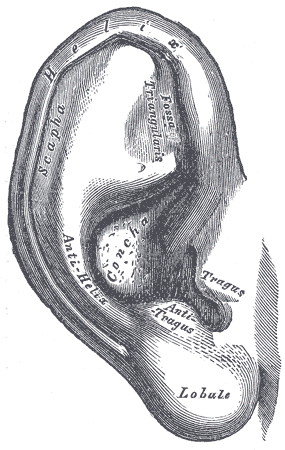
The wrinkles and folds of our ears aren’t just bizarre and useless vestiges like human tailbones, webbed feet, wisdom teeth, or appendixes. In fact, complex outer ears like ours are an evolutionary breakthrough. You won’t find protruding ears on less-developed creatures like fish and lizards. Human ears, on the other hand, are complex sound-catchers. The odd bulges and crevices of the pinna (the visible part of the ear) are designed to amplify sounds relevant to humans, especially the sounds of speech. As Robert Jourdain explains in Music, the Brain, and Ecstasy, “Our pinnae are too small to reflect the long waves that constitute low-frequency sound; they boost only high-frequency components…those most important for speech.” Thanks to the logic of Mother Nature, the sounds we produce when speaking are the same sounds we can hear the best.
Along with our enhanced perception of speech, our perception of music is also influenced by our ears’ slight bias towards higher-frequency sounds. To our ears, a high-pitched piccolo may seem to cut through the orchestra more easily than a low-pitched tuba. Because of their high-frequency-boosting shape, our pinnae make music sound slightly “sweeter,” according to Jourdain. This is true of recorded music as well as live music.
One common misconception of recorded music is that microphones are used exactly like our ears to capture sound. However, unlike our ears, most recording microphones are designed to capture a broad range of frequencies equally well. This allows the music to be played back on speakers with all its natural sounds intact. Our ears then filter the sounds just as we would at a live concert.
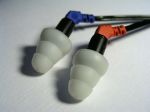 But what happens when we completely skip our pinnae and stick earbuds or in-ear headphones straight into our ear canals? Naturally, the sound changes. Our pinnae no longer amplify the same high frequencies they would when listening to the music through speakers or on-ear headphones. So in theory, music piped straight through to our ear canal will sound a bit duller than music that gets reflected through our pinnae.
But what happens when we completely skip our pinnae and stick earbuds or in-ear headphones straight into our ear canals? Naturally, the sound changes. Our pinnae no longer amplify the same high frequencies they would when listening to the music through speakers or on-ear headphones. So in theory, music piped straight through to our ear canal will sound a bit duller than music that gets reflected through our pinnae.
In reality, though, no pair of headphones or set of speakers recreates live music perfectly, with all frequencies intact. So the average music listener does not consciously perceive this slight frequency difference due to these pinnae reflections. Only the most obsessed audiophile would claim that a lack of pinnae reflections makes music less enjoyable.
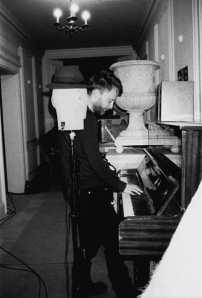
Radiohead's Thom Yorke and a dummy head for binaural recording
On the other hand, some imaginative audio engineers have begun using the unique shape of our ears to reinvent the recording process and create incredibly realistic listening experiences. Instead of using traditional microphones, they place two small microphones inside the “ear canals” of an artificial human head. They can then place this “dummy head” anywhere inside a concert hall, even in the middle of an orchestra. The resulting recording will be the sum total of all the sounds from the orchestra bouncing through the dummy’s pair of “ears” and into the microphones. Because of the stereo effect and the natural ear reflections recorded by these dummy head microphones, the listener will feel transported to the concert hall, hearing the orchestra in 360 degrees around his or her head. Expect this eerily-realistic effect (known as binaural dummy head recording) to be used in more and more recordings.
Listen with in-ear headphones to this binaural audio sample from the Wikimedia Commons:
The dummy head recording method was used in this Revolt music video:
Charlie McCarron
Sound Consultant
soundlounge
Posted in Audio Perception | Tags: binaural, ears, evolution, perception, pinnae, Radiohead, recording, Robert Jourdain
Capturing The Sound of the Brand – the return of the jingle?
soundlounge Jukebox
Sound Branding in the Soundtrack of Life

We all know that brands love music but if they are to use sound to emotionally engage with consumers then understanding exactly how it affects them has to be at the very heart of sound branding. While great luminaries like Dr Daniel Levitin – Professor of Psychology and Behavioural Neuroscience and author of the groundbreaking ‘Your Brain on Music’ – have been considering this on an intellectual level for many years, agencies still appear to be dragging their heels when it comes to putting a science to the art of sound branding. But last week, Levitin’s scientific paper Life Soundtrack (commissioned by Philips Consumer Electronics in 2007) re-emerged in the somewhat unlikely format of an article in Men’s Health Magazine. According to the report, music affects the human brain in a huge variety of ways, allowing us to utilise certain types or genres of music to help complete different tasks. This is supported by consumer analysis carried out by Entertainment Media Research (EMR) which found that an impressive 82 per cent of us use music to boost our spirits. It also revealed that 75 per cent of people use music when they are engaged in a physical activity from housework to the gym and even sex!
But it’s not just physical activities which can be enhanced or made easier by the presence of certain sound. “Music has been shown to have specific effects on the body’s physiology, including heart rate, respiration, sweating, and mental activity,” explains Levitin. As anyone with a roommate at university will have no doubt discovered, some students find it easier to work in silence while others struggle to stay interested in the task at hand without some background noise. The report shows, however, that it would be too simple for us to just look to genre or tempo to find the appropriate music for study. Indeed, when studying text or anything else that requires verbal cognition “it is better to have instrumental music so as not to saturate the limited capacity of the attention system for verbal material”. Something like Mike Oldfield’s Tubular Bells is therefore much more likely to get you through those finals than tunes packed with distracting lyrical content. Guess that rap CD is out then!
And in these financially tumultuous times, many of us find it difficult to relax in the evenings and dozing off to sleep can seem a mammoth task in itself. But people still use music to help them to drift off. For the majority, songs with a slower tempo and lighter beat are “contemplative, relaxing and hypnotic”, such as that well-known sleep inducer Brahms’ Lullaby. However, much of a song’s ability to relax you is not related to bmp but to its “feel” factor. Fleetwood Mac’s song Hypnotized, is found to be indeed hypnotic by many listeners despite its fast tempo of 108 bpm. “In general, relaxing and sleep-inducing music avoids rapid changes in timbre, pitch, loudness or rhythm,” says Levitin. “Music with a large dynamic range (a Beethoven or Mahler symphony) is going to pull the listener out of their reverie during the intense parts, as opposed to music with less of a dynamic range.” Suggested tracks for banishing those sleepless nights include Bach: Oboe Concertos, Triple Concerto, Flute Concerto, Bill Evans’ The Village Vanguard Sessions, Chopin Nocturnes or Peter, Paul & Mary’s Greatest Hits. What tracks send you off every time? [**link to Facebook**]? And for all you lovers out there … what of romance? As many a young couple have discovered there is no simple formula here. However, it would appear that those that share musical tastes “usually find it easy to discover the optimal music for their romantic time together”.
Despite being originally unveiled more than two years ago, the publication of Levitin’s findings in a popular, glossy magazine this month proves that the issue of our response to music is becoming even more mainstream. It would seem that we don’t just want to simply listen, we are becoming ever more curious to understand why. From a brand perspective this now opens yet another dimension to the list of required insights for sound branding. Increasingly, understanding why and how sound is moderating arousal levels and concentration through its impact on the brain’s chemistry is becoming part of the equation. Because sound evokes such a visceral reaction beyond the control of the conscious mind, realising which songs will keep consumers shopping for longer, what tracks will stop viewers switching channels in an ad break and most importantly what sound connects a brand in a more genuine way to their consumers is fast moving from an interesting option to a must do.
At soundlounge we believe that it’s time for brands to start to apply the rigours of science to the art of music.







